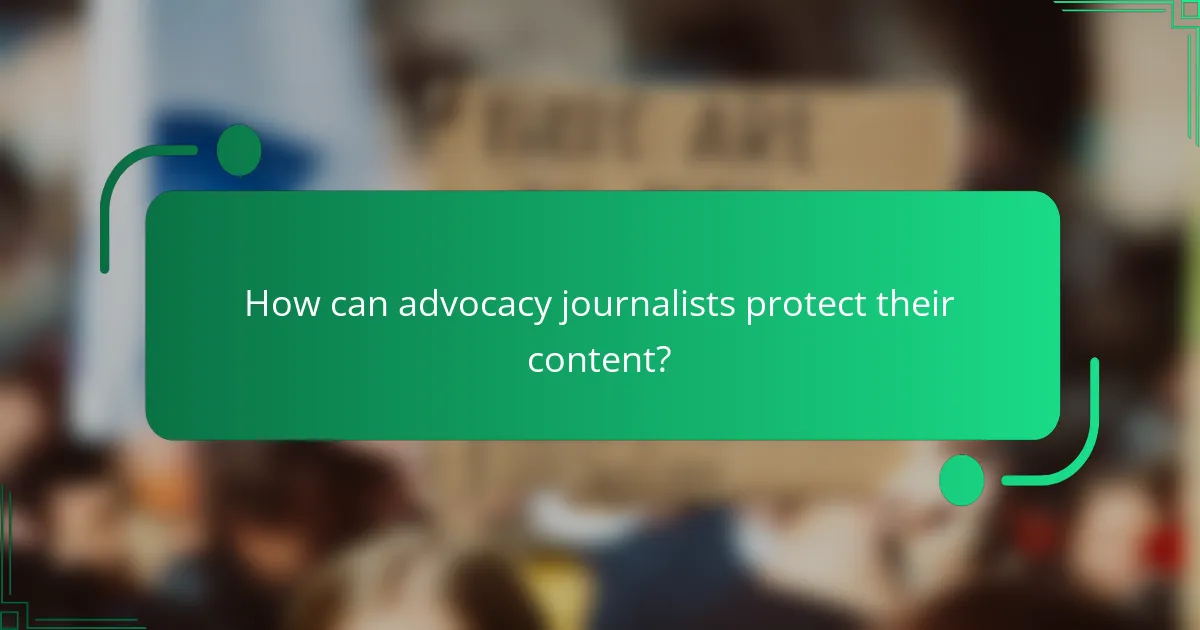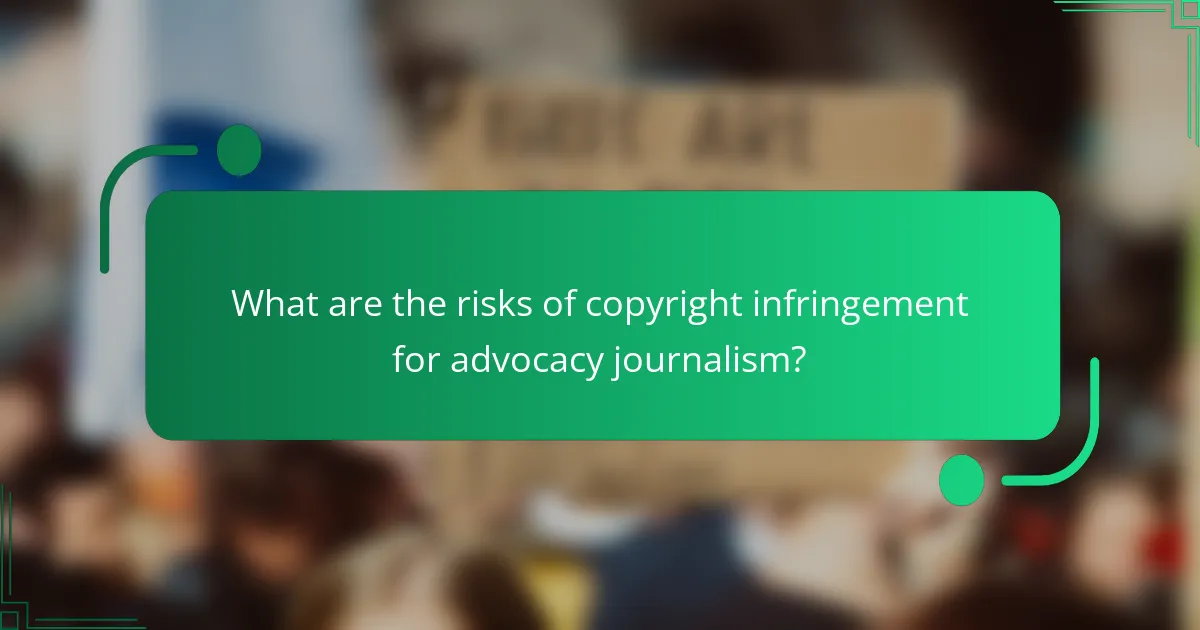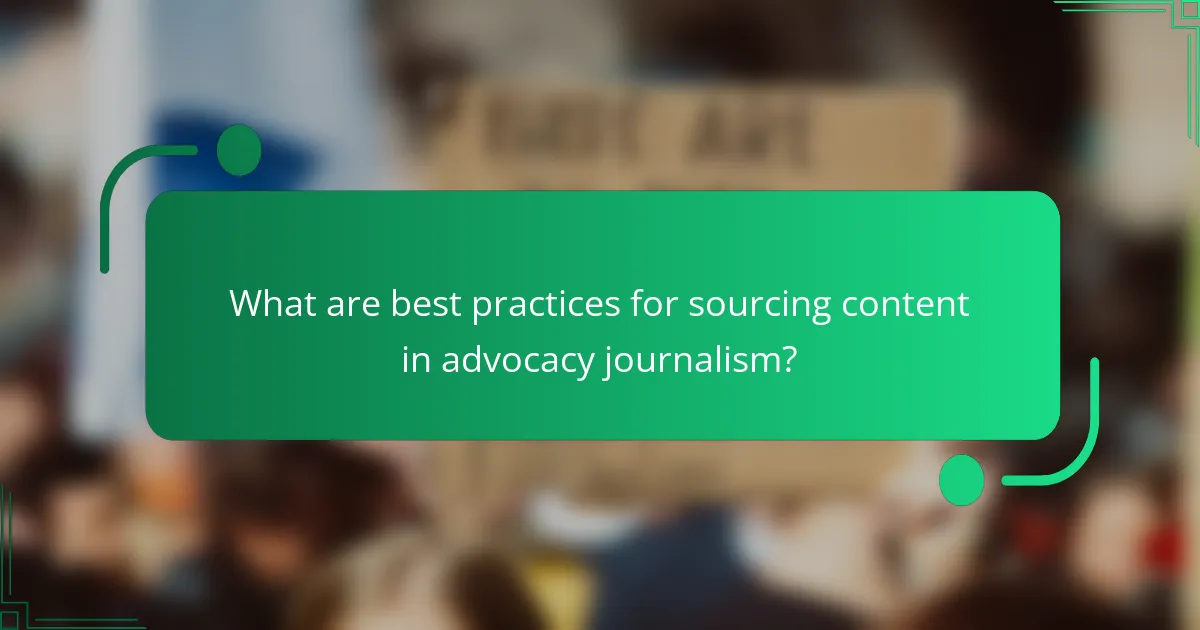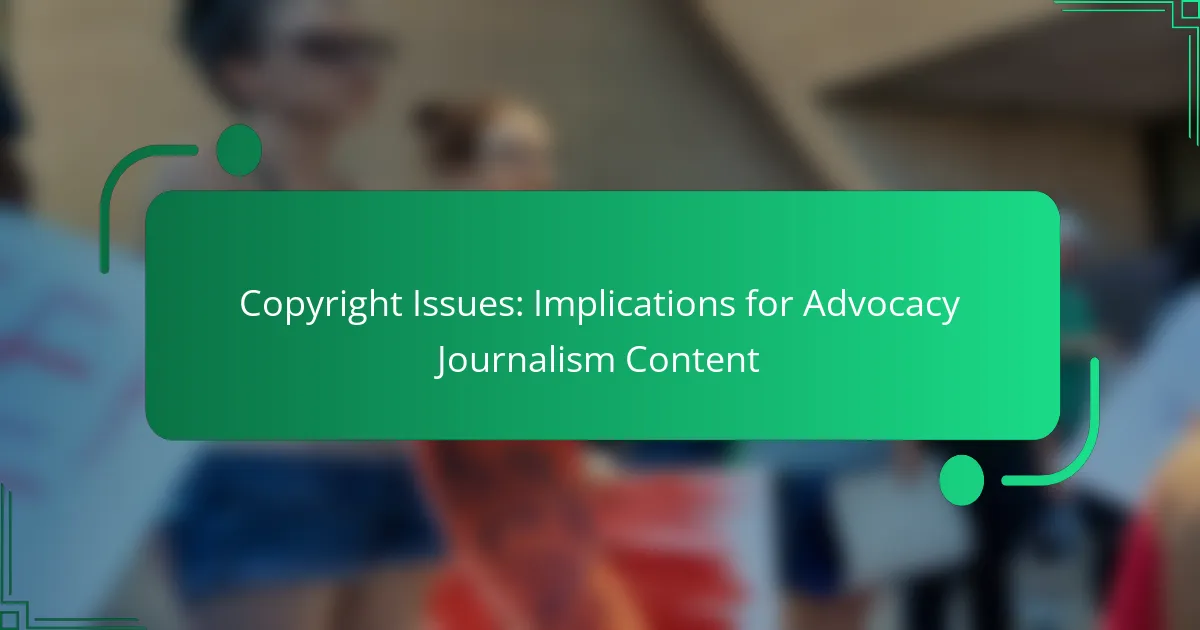Advocacy journalism faces unique challenges due to the intricate landscape of copyright laws, which can significantly affect how content is created and shared. Understanding these legal implications is essential for journalists to safeguard their work and effectively promote their causes without falling into legal traps.

What are the copyright implications for advocacy journalism in the United States?
Advocacy journalism in the United States must navigate complex copyright laws that can impact content creation and distribution. Understanding these implications is crucial for journalists to avoid legal pitfalls while effectively promoting their causes.
Fair use doctrine
The fair use doctrine allows limited use of copyrighted material without permission under specific circumstances. For advocacy journalism, this can include commentary, criticism, or educational purposes, but the use must meet certain criteria such as the purpose of use, the nature of the copyrighted work, the amount used, and the effect on the market value.
For example, quoting a few sentences from a book in a critique may qualify as fair use, while using an entire chapter likely would not. Journalists should assess each situation carefully to determine if their use falls under fair use.
Public domain resources
Public domain resources are materials not protected by copyright, allowing anyone to use them freely. This includes works created by the U.S. government, as well as older works whose copyright has expired.
Advocacy journalists can leverage public domain content to enhance their storytelling without legal concerns. However, verifying that a resource is indeed in the public domain is essential to avoid unintentional infringement.
Attribution requirements
Attribution is the practice of crediting the original creator of a work, which is crucial in advocacy journalism to maintain ethical standards and avoid plagiarism. While not always legally required, providing attribution is a best practice that respects the rights of original authors.
When using third-party content, journalists should clearly cite the source, including the author’s name and the title of the work. This not only enhances credibility but also fosters a culture of respect within the journalism community.

How can advocacy journalists protect their content?
Advocacy journalists can protect their content through copyright registration, utilizing Creative Commons licenses, and implementing effective content management strategies. These methods help ensure that their work is legally safeguarded and that they maintain control over how it is used by others.
Copyright registration
Copyright registration provides legal recognition of a journalist’s ownership of their work. In many countries, including the United States, registering a copyright can enhance legal protections and make it easier to pursue infringement claims. While registration is not mandatory, it is highly recommended for those who want to enforce their rights effectively.
The process typically involves submitting an application to the relevant copyright office along with a copy of the work and a fee, which can vary by jurisdiction. For example, in the U.S., the fee for electronic registration is generally around $35 to $55.
Creative Commons licenses
Creative Commons licenses allow advocacy journalists to specify how their work can be used by others. These licenses range from allowing full sharing with attribution to restricting commercial use or derivative works. By choosing the appropriate license, journalists can promote their content while retaining certain rights.
For instance, a journalist might select a Creative Commons Attribution-NonCommercial license, permitting others to share and adapt their work as long as it is not used for commercial purposes. This approach can help expand the reach of their advocacy while protecting their interests.
Content management strategies
Implementing effective content management strategies is crucial for advocacy journalists to safeguard their work. This includes keeping detailed records of all published materials, including dates, platforms, and any licenses applied. Such documentation can be invaluable in case of disputes over ownership or usage rights.
Additionally, using digital tools to monitor the use of their content online can help journalists identify unauthorized use quickly. Tools like Google Alerts or specialized copyright monitoring services can notify them when their work appears elsewhere, allowing for timely action if necessary.

What are the risks of copyright infringement for advocacy journalism?
Copyright infringement poses significant risks for advocacy journalism, including legal consequences, damage to reputation, and financial losses. Journalists must navigate copyright laws carefully to avoid these pitfalls while effectively advocating for their causes.
Legal penalties
Engaging in copyright infringement can lead to serious legal penalties, including lawsuits and monetary damages. Depending on the severity of the infringement, penalties can range from a few hundred to several thousand dollars, or even more in egregious cases.
In the United States, the Copyright Act allows for statutory damages, which can be awarded even if the copyright owner did not suffer actual losses. This means that a journalist could face significant financial liability for unauthorized use of copyrighted materials.
Loss of credibility
Copyright infringement can severely damage a journalist’s credibility, undermining their authority and trustworthiness. Advocacy journalism relies on public perception; if audiences perceive a journalist as unethical or untrustworthy, their message may be disregarded.
Furthermore, losing credibility can have long-term effects on a journalist’s career, making it difficult to secure future opportunities or partnerships. Maintaining ethical standards is crucial for sustaining a positive reputation in the field.
Financial repercussions
The financial repercussions of copyright infringement can be extensive, including legal fees, settlements, and potential loss of income. Journalists may find themselves facing unexpected costs that can strain their resources and impact their ability to continue their work.
In addition to direct costs, advocacy journalists may also experience a decline in funding or sponsorship opportunities if they are associated with copyright violations. This can hinder their ability to produce quality content and advocate effectively for their causes.

What are best practices for sourcing content in advocacy journalism?
Best practices for sourcing content in advocacy journalism involve ensuring proper attribution, using licensed materials, and verifying ownership of the content. These steps help maintain ethical standards and protect against copyright infringement while promoting transparency and credibility.
Crediting original authors
Crediting original authors is essential in advocacy journalism to acknowledge their contributions and avoid plagiarism. Always include the author’s name and the source of the material, whether it’s a quote, image, or data. This practice not only respects intellectual property rights but also enhances the credibility of your work.
When citing sources, consider using a consistent citation style, such as APA or MLA, to provide clarity. For online content, hyperlinks can be an effective way to direct readers to the original work, making it easy for them to verify the information.
Using licensed media
Using licensed media ensures that you have the legal right to use images, videos, and other content in your advocacy journalism. Many platforms offer licensed media, such as Creative Commons or stock photo websites, where you can find materials that fit your needs. Always check the licensing terms to understand how you can use the content.
For example, some licenses allow for modification and commercial use, while others may restrict usage to non-commercial purposes only. Familiarize yourself with these terms to avoid potential legal issues and to respect the rights of content creators.
Verifying content ownership
Verifying content ownership is crucial before using any material in advocacy journalism. This involves checking the copyright status of images, articles, or data to ensure you have permission to use them. Tools like reverse image search can help identify the original source of an image and its licensing status.
When in doubt, reach out to the content creator for clarification or permission. This proactive approach not only protects you legally but also fosters good relationships within the journalism community.

How does copyright law affect multimedia content in advocacy journalism?
Copyright law significantly impacts multimedia content in advocacy journalism by protecting the rights of creators while imposing restrictions on the use of their work. Journalists must navigate these laws to avoid infringement while effectively conveying their messages through images, videos, and audio.
Image copyright issues
Images used in advocacy journalism are often protected by copyright, meaning that unauthorized use can lead to legal consequences. Journalists should seek permission from the copyright holder or use images that are in the public domain or licensed under Creative Commons.
When using stock images, it’s crucial to understand the licensing agreements, which may restrict usage to specific contexts or require attribution. Always verify the terms to avoid potential disputes.
Video content restrictions
Video content in advocacy journalism is subject to copyright laws that protect the original creators. This means that using clips from films, documentaries, or other media without permission can result in copyright infringement claims.
To legally incorporate video, journalists can use licensed footage or create original content. Fair use may apply in some cases, but it is a complex legal doctrine that should be approached with caution. Consulting a legal expert can help clarify these issues.
Audio rights management
Audio content, including music and sound bites, is also protected under copyright law. Using copyrighted audio without permission can lead to significant legal challenges, so it is essential to obtain the necessary licenses or use royalty-free music.
When producing podcasts or audio segments, consider platforms that offer licensed music or sound effects. Additionally, be aware of the terms of use for any audio clips to ensure compliance with copyright regulations.

What are the emerging trends in copyright law affecting advocacy journalism?
Emerging trends in copyright law are significantly impacting advocacy journalism by reshaping how content is created, shared, and protected. Key developments include the rise of AI-generated content, changes in international treaties, and a growing emphasis on open access publishing.
Impact of AI-generated content
AI-generated content is increasingly prevalent in journalism, raising questions about authorship and copyright ownership. When an AI creates an article or visual, determining who holds the copyright can be complex, often depending on the level of human involvement in the creation process.
Advocacy journalists should be cautious when using AI tools, ensuring they understand the licensing agreements associated with these technologies. It’s essential to verify whether the AI-generated material is free to use or if it requires attribution or payment.
Changes in international copyright treaties
Recent updates to international copyright treaties are affecting how advocacy journalism operates across borders. These changes often aim to harmonize copyright laws, making it easier for journalists to share content internationally while also protecting their rights.
Advocacy journalists must stay informed about these treaties, as they can influence the availability of resources and the legal framework for sharing information. Understanding the implications of these treaties can help journalists navigate potential legal challenges when working on cross-border stories.
Shift towards open access publishing
The shift towards open access publishing is transforming how advocacy journalism disseminates information. Open access allows for free public access to research and articles, which can enhance the reach and impact of advocacy efforts.
Journalists should consider publishing their work in open access formats to maximize visibility and engagement. However, they should also be aware of the potential trade-offs, such as the need for funding models to support this type of publishing and the implications for copyright ownership.
